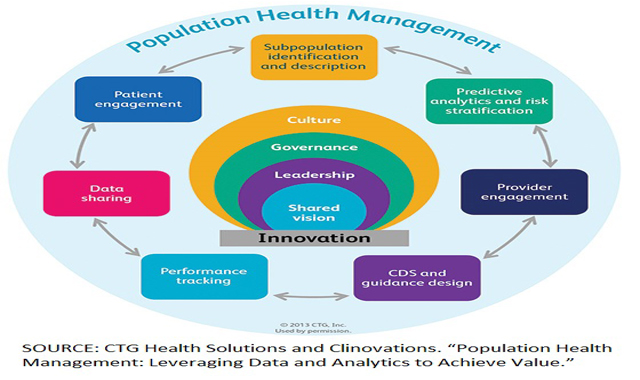Population health information management (PHIM) is the next big thing on the horizon for health information professionals, according to Bonnie Cassidy, MPA, RHIA, FAHIMA, FHIMSS. As medicine shifts towards a “big picture” view of managing the long-term health of patient populations, HIM experts will become the stewards of a brand new type of data, and should start developing the strategies necessary to use that information in order to reduce preventable readmissions, manage chronic diseases, and give physicians the tools to rein in the unsustainable growth of healthcare costs.
“Population health management (PHM) lowers costs by refocusing healthcare on not just the sick but also the well,” Cassidy writes. “The goal of PHM is to keep a patient population as healthy as possible and reduce the need for expensive interventions like tests, emergency department visits, hospitalizations, and procedures. While most healthcare providers see the critical importance of PHM, they do not have the information technology, the required understanding of PHIM, or the data management skills and resources that are required to successfully utilize population health management.”
“Some of the first things that must be understood when launching a PHM program is what a population of healthy people looks like, how clinical risk is defined, how financial risk is measured, and what will be the metrics used to analyze how sick patients with chronic disease do and do not get sicker,” Cassidy explains. “PHM programs also track and trend inpatient, ambulatory, and emergency department patients.”
PHM makes use of patient data registries and data banks to create a portrait of a certain population and analyze trends to find solutions to problematic behaviors and connect care gaps that may leave certain segments chronically underserved. Using population health data to its fullest extent and achieving complete data integration will “redesign the way providers approach and deliver care” while taking advantage of existing health IT initiatives, like electronic health records and health information exchange, that represent huge investments for hospitals and physicians.
HIM professionals should be the leaders in EHR and HIE information governance, clinical documentation integrity, and quality data analytics by collecting the right information, storing it in a meaningful and accessible way, and analyzing the data to draw helpful conclusions that actively impact the way patients are viewed and treated. “As PHM programs expand, comprehensive and fully interfaced PHM-EHR solutions will emerge as well,” predicts Cassidy. “PHIM professionals must develop expertise within these systems in order to provide value added recommendations to the care team on the clinical documentation requirements needed for data gathering.”
“For the past 85 years, the HIM profession has been in the pivotal role of highlighting the importance of clinical documentation integrity and compliance,” she concludes, “whether the information was on index cards, paper medical records, dictation and transcription, hybrid or electronic patient records. Current and future HIM professionals should aim to lead the healthcare industry into the next generation of health informatics and data analytics. Embracing PHM and creatively developing new analytic tools and techniques will enable a new generation of PHIM professionals to be successful.” Source




















